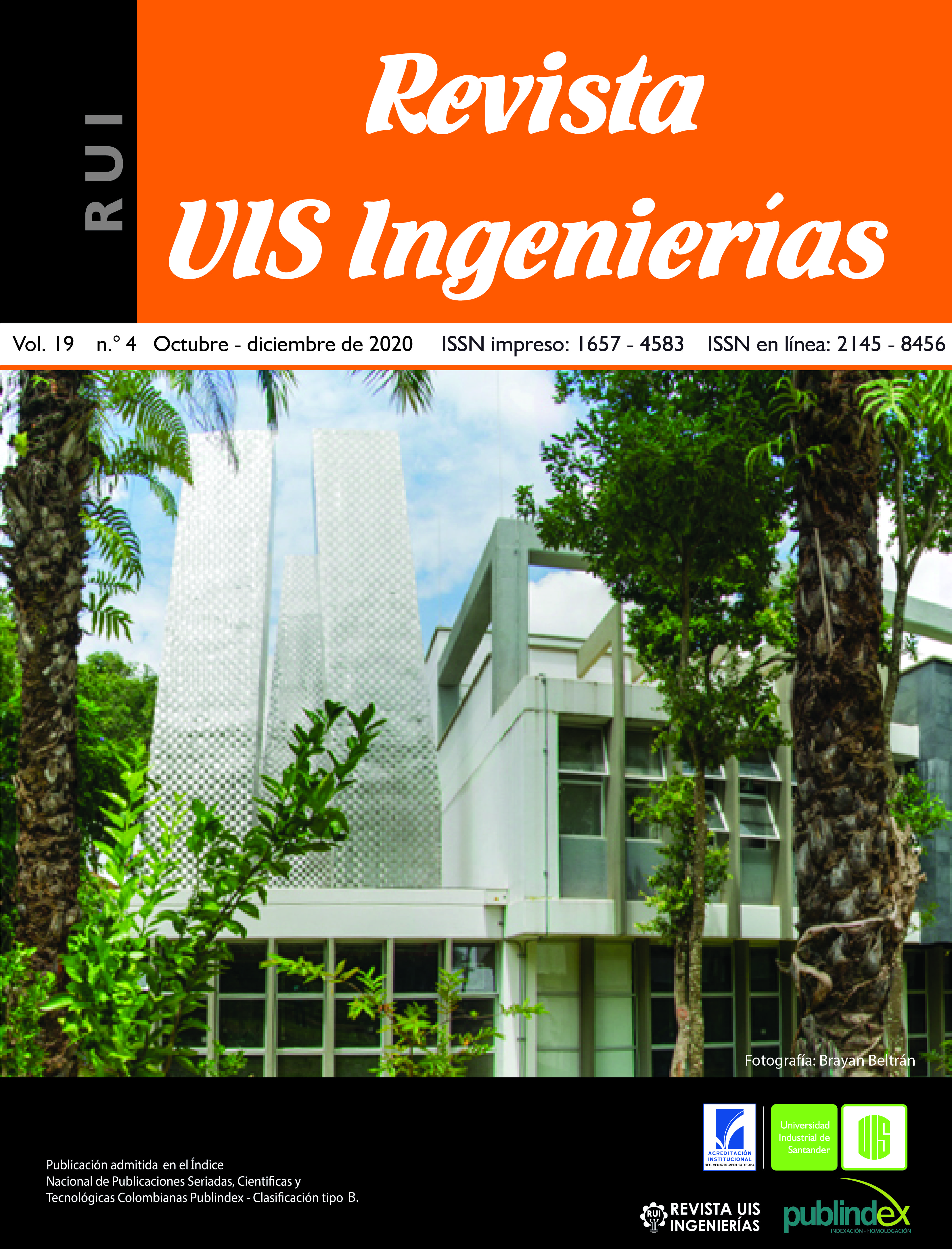Discrete-time inverse optimal control for a reaction wheel pendulum: a passivity-based control approach
Published 2020-09-23
Keywords
- reaction wheel pendulum,
- stability analysis,
- passivity-based control,
- Lyapunov functions,
- discrete analysis
- inverse optimal control ...More
How to Cite
Copyright (c) 2020 Revista UIS Ingenierías

This work is licensed under a Creative Commons Attribution-NoDerivatives 4.0 International License.
Abstract
In this paper it is presented the design of a controller for a reaction wheel pendulum using a discrete-time representation via optimal control from the point of view of passivity-based control analysis. The main advantage of the proposed approach is that it allows to guarantee asymptotic stability convergence using a quadratic candidate Lyapunov function. Numerical simulations show that the proposed inverse optimal control design permits to reach superior numerical performance reported by continuous approaches such as Lyapunov control functions and interconnection, and damping assignment passivity-based controllers. An additional advantage of the proposed inverse optimal control method is its easy implementation since it does not employ additional states. It is only required a basic discretization of the time-domain dynamical model based on the backward representation. All the simulations are carried out in MATLAB/OCTAVE software using a codification on the script environment.
Downloads
References
[2] E. N. Sanchez, F. Ornelas-Tellez, Discrete-Time Inverse Optimal Control for Nonlinear Systems. Boca ratón, FL, USA: CRC Press Taylor and Francis Group, May 2017.
[3] M. Kanazawa, S. Nakaura, M. Sampei, “Inverse optimal control problem for bilinear systems: Application to the inverted pendulum with horizontal and vertical movement,” in Proceedings of the 48h IEEE Conference on Decision and Control (CDC) held jointly with 2009 28th Chinese Control Conference, pp. 2260-2267, doi: 10.1109/CDC.2009.5399912
[4] S. J. Lee, T.-C. Tsao, “Repetitive learning of backstepping controlled nonlinear electrohydraulic material testing system,” Control Eng. Pract., vol. 12, no. 11, pp. 1393-1408, 2004, doi: 10.1016/j.conengprac.2004.02.011
[5] J. G. Valenzuela, O. D. Montoya, D. Giraldo-Buitrago, “Local control of reaction wheel pendulum using fuzzy logic,” Scientia et Technica, vol. 18, no. 4, pp. 623-632, 2013.
[6] M. W. Spong, P. Corke, R. Lozano, “Nonlinear control of the Reaction Wheel Pendulum,” Automatica, vol. 37, no. 11, pp. 1845-1851, 2001. doi: 10.1016/S0005-1098(01)00145-5
[7] O. D. Montoya, L. F. Grisales-Noreña, V. D. Correa-Ramírez, D. Giraldo-Buitrago, “Global control of reaction wheel pendulum through energy regulation and extended linearization of the state variables,” Tecno Lógicas, vol. 17, no. 32, pp. 33-46, Jun. 2014.
[8] O. D. Montoya, W. Gil-González, “Nonlinear analysis and control of a reaction wheel pendulum: Lyapunov-based approach,” Engineering Science and Technology, an International Journal, vol. 23, no. 1, pp. 21-29, 2020, doi: 10.1016/j.jestch.2019.03.004
[9] D. J. Block, K. J. Åström, M. W. Spong, “The reaction wheel pendulum,” Synthesis Lectures on Control and mechatronics, vol. 1, no. 1, pp. 1-105, 2007, doi: 10.2200/S00085ED1V01Y200702CRM001
[10] O. D. Montoya, C. A. Ramírez, L. F. Grisales, “Global Control of Reaction Wheel Pendulum Using Artificial Neural Networks and Extended Linearization,” Scientia et technica, vol. 22, no. 20, pp. 130-140, jun 2017.
[11] K. Srinivas, L. Behera, “Swing-up control strategies for a reaction wheel pendulum,” Int. J. Syst. Sci., vol. 39, no. 12, pp. 1165-1177, 2008, doi: 10.1080/00207720802095137
[12] B. Bapiraju, K. N. Srinivas, P. P. Kumar, L. Behera, “On balancing control strategies for a reaction wheel pendulum,” in Proceedings of the IEEE INDICON 2004. First India Annual Conference, 2004, pp. 199-204, doi: 10.1109/INDICO.2004.1497738
[13] V. D. Correa, D. G. A. Escobar, “Fuzzy control of an inverted pendulum Driven by a reaction wheel using a trajectory tracking scheme,” TecnoLogicas, vol. 20, no. 39, pp. 1-13, 2017.
[14] O. D. Montoya, V. M. Garrido, W. Gil-González, C. Orozco- Henao, “Passivity-Based Control Applied of a Reaction Wheel Pendulum: an IDA-PBC Approach,” in 2019 IEEE International Autumn Meeting on Power, Electronics and Computing (ROPEC), 2019, pp. 1-6, doi: 10.1109/ROPEC48299.2019.9057105
[15] A. M. El-Nagar, M. El-Bardini, N. M. EL-Rabaie, “Intelligent control for nonlinear inverted pendulum based on interval type-2 fuzzy PD controller,” Alexandria Engineering Journal, vol. 53, no. 1, pp. 23-32, 2014, doi: 10.1016/j.aej.2013.11.006
[16] S. Enev “Feedback linearization control of the inertia wheel pendulum,” Cybernetics and Information Technologies, vol. 14, no. 3, pp. 96-109, 2014, doi: 10.2478/cait-2014-0036
[17] S. Irfan, A. Mehmood, M. T. Razzaq, J. Iqbal, “Advanced sliding mode control techniques for Inverted Pendulum: Modelling and simulation,” Engineering Science and Technology, an International Journal, vol. 21, no. 4, pp. 753-759, 2018, doi: 10.1016/j.jestch.2018.06.010
[18] C. Atkinson, A. Osseiran, “Discrete-space time-fractional processes,” Fractional Calculus and Applied Analysis, vol. 14, no. 2, 2011, doi: 10.2478/s13540-011-0013-9
[19] R. G. Sanfelice, “On the Existence of Control Lyapunov Functions and State-Feedback Laws for Hybrid Systems,” IEEE Trans. Autom. Control, vol. 58, no. 12, pp. 3242–3248, Dec 2013, doi: 10.1109/TAC.2013.2264851
